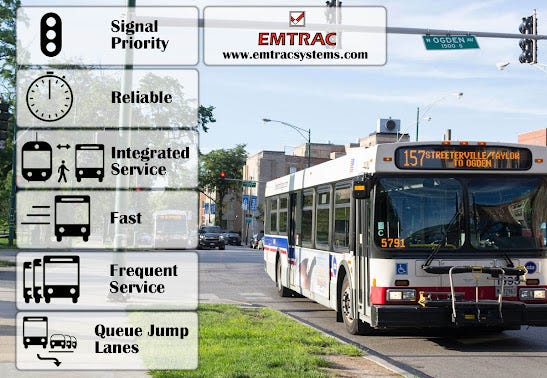Benefits of using Transit Signal Priority
Transit Signal Priority (TSP) makes use of existing vehicle location and wireless communication technologies to extend the green light of a traffic signal to allow a Pace bus or CTA to continue through an intersection when the bus is lagging behind schedule — helping in reducing travel times and ensure on-time arrivals.
When we discuss Transit Signal Priority, the basic fact is that using Preemption and Priority settings for traffic signals can change the signal timing and prioritize specific types of vehicles such as buses, trucks, emergency vehicles, or trains. This system primarily aims to speed up the travel times, improve safety, and give way for priority vehicles to reach their next destination.
More than 50 percent of the region’s transit riders can take advantage of faster, more dependable bus service. On Transit Signal Priority equipped buses, riders will see significantly fewer traffic signal delays, enabling them to reach their destinations on time — with minimal interruption to regular traffic flow. Traffic signal synchronization will be improved along these corridors as part of the Transit Signal Priority (TSP) program.
What is the difference between Bus Signal Priority & Preemption
When we talk about more reliable or faster transit services, the setting of red and green lights is crucial. Therefore, Traffic or Bus Signal Priority is helpful for any street-running transit vehicle, like buses, light rail, or streetcars. BSP is being more widely installed in North America to direct traffic congestion due to traffic signals for on-street transit services. Signal priority for transit vehicles helps in improving transit operations and service quality. BSP offers lesser benefits in areas with high bus volumes or very light traffic. So the most suitable priority method would be one that combines the various elements of existing priority techniques. At the same time, preemption is used at intersections with traffic signals to give the green light to buses, light rail, streetcar, trucks, emergency vehicles, or trains. The primary purpose of preemption is to reduce travel times, enhance safety, and clear a path so that the priority vehicle can reach its next stop or destination faster.
Bus Signal priority and preemption work well for any situation that needs to prioritize certain vehicles to clear a singular intersection or multiple ones within a corridor. Preemption will be typically used within congested corridors.
Emtrac Systems provides you with the best Bus Signal Priority (BSP) system that adjusts the traffic timing, eventually reducing the amount of time a transit vehicle spends waiting at a red light.

What does the red light on a bus mean?
The red and green lights setting is crucial when we talk about more reliable or faster transit services. Therefore, Traffic or Bus Signal Priority is beneficial for any street-running transit vehicle, such as buses, light rail, or streetcars.
Emtrac’s Transit Signal Priority (TSP) system adjusts the traffic timing, eventually reducing the amount of time a transit vehicle spends waiting at a red light. One may see extended green times through the intersection without stopping or shorten red times so a stopped vehicle can get moving again.
Transit Signal Priority (TSP) is a Advanced Traffic and Bus signal Priority Management Systems or mechanism to provide special treatment and reduce dwell time to transit vehicles such as bus, rapid transit vehicle, railroad car, water vehicle, municipal vehicles, law enforcement and fire safety vehicle at signalized intersections.
Transit Signal Priority system requires some hardware equipment vehicle detectors and specialized traffic signal controllers.



Comments
Post a Comment